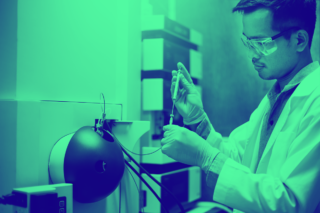Optimized assay for lipid normalization in LC-MS/MS applications

If you’ve been following us for a while, you know how quickly the lipidomics research area is growing. As the role of lipids in health and disease have become more widely understood, it should come as no surprise that quantifying lipids in cells has become increasingly more important. Using LC-MS/MS methods to conduct relative quantitative lipidomics studies is fairly routine, but currently there is no consensus on the best way to normalize lipid concentrations.

from 2002 - 2022
There are several common methods for lipid concentration normalization, each with its own advantages and, more importantly, its own disadvantages. Dr. Kari Basso and her team at the University of Florida’s Mass Spectrometry Research and Education Center published a study optimizing a well-established quantitative colorimetric method for the total lipid normalization in LC-MS/MS applications.
The method is called the sulfo-phospho-vanillin assay (SPVA) and has been around since the 1930s. Originally designed to estimate total lipids in serum, it is important to note that this method is not lipid class limited. If you want more details on the SPVA method, well you’re just going to have to check out Kari’s publication in Analytical Chemistry. But we’ll jump right into the work that Kari’s team did to optimize the method for untargeted quantitative lipidomics studies.
The key goals of this study were to (1) optimize the method for any sample type that might contain all or most lipid classes, (2) optimize the method’s efficiency and reproducibility in a 96-well plate, and ultimately (3) normalize lipid concentrations in LC-MS applications. Kari and her team decided to use several Avanti products to carry out this study including E. coli and porcine brain total lipid standards as well as the SPLASH™ LIPIDOMIX™ Mass Spec Standard.

As the name implies, the SPVA requires the use of sulfuric acid, phosphoric acid and vanillin. Sulfuric acid is first added to lipid extracts to react with all unsaturated lipids. The phosphoric acid is used to dissolve vanillin which in an acidic environment reacts to form a more reactive species capable of reacting with the lipid cation. This final reaction produces a colored complex that can be measured around 520-550 nm. To optimize the SPVA method, Kari’s team needed to optimize:
- Sulfuric acid concentration
- Phosphoric acid concentration
- Wavelength and incubation time
Please read the full article for details on optimization methods and optimized conditions. Once the optimized conditions were determined, they applied the conditions to both E. coli and porcine brain total lipid standards. Each standard was tested at randomly chosen low, medium, and high concentrations, as well as with three different sample volumes (10µL, 20µL, and 50µL) to obtain three calibration curves. During the quantitation experiment it was observed that the 10µL samples had calibration curves with poor linearity and low absorbance. Doubling the sample volumes to 20µL resulted in improved overall linearity, but high error of the calibration curves. And using the 50µL samples improved both the linearity and standard deviation of the calibration curves with errors at or below 10%.
The final assessment of the optimized method was an LC-MS/MS analysis. Avanti’s SPLASH™ LIPIDOMIX™ Mass Spec Standard was applied to the samples for quality control. The LC-MS/MS analysis showed reduced relative standard deviations and increased relative lipid changes by lipid normalization. To read the full article and the amazing work Kari’s team did, click the link!
Thank you, Kari, for trusting Avanti’s lipidomic standards for your research, and for letting us know that your exciting work was published in Analytical Chemistry. We look forward to seeing the amazing work you’ll continue to do with our lipids!
Stay tuned for our next Lipid Leaders interview featuring Dr. Kari Basso!